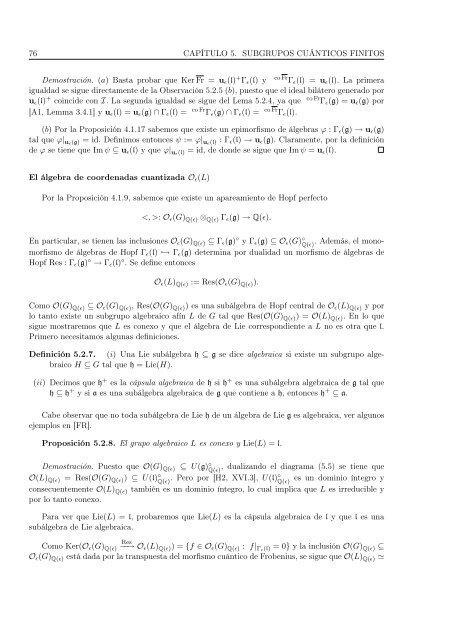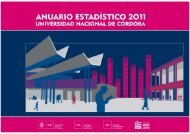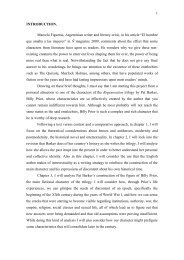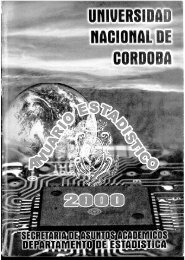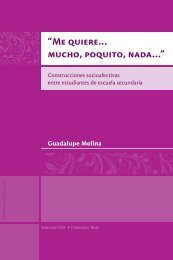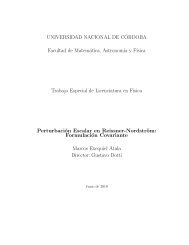Abrir - RDU - Universidad Nacional de Córdoba
Abrir - RDU - Universidad Nacional de Córdoba
Abrir - RDU - Universidad Nacional de Córdoba
You also want an ePaper? Increase the reach of your titles
YUMPU automatically turns print PDFs into web optimized ePapers that Google loves.
76 CAPÍTULO 5. SUBGRUPOS CUÁNTICOS FINITOS<br />
Demostración. (a) Basta probar que Ker Fr = u ɛ (l) + Γ ɛ (l) y<br />
co Fr Γ ɛ (l) = u ɛ (l). La primera<br />
igualdad se sigue directamente <strong>de</strong> la Observación 5.2.5 (b), puesto que el i<strong>de</strong>al bilátero generado por<br />
u ɛ (l) + coinci<strong>de</strong> con I. La segunda igualdad se sigue <strong>de</strong>l Lema 5.2.4, ya que co Fr Γ ɛ (g) = u ɛ (g) por<br />
[A1, Lemma 3.4.1] y u ɛ (l) = u ɛ (g) ∩ Γ ɛ (l) = co Fr Γ ɛ (g) ∩ Γ ɛ (l) = co Fr Γ ɛ (l).<br />
(b) Por la Proposición 4.1.17 sabemos que existe un epimorfismo <strong>de</strong> álgebras ϕ : Γ ɛ (g) → u ɛ (g)<br />
tal que ϕ| uɛ (g) = id. Definimos entonces ψ := ϕ| uɛ (l) : Γ ɛ (l) → u ɛ (g). Claramente, por la <strong>de</strong>finición<br />
<strong>de</strong> ϕ se tiene que Im ψ ⊆ u ɛ (l) y que ϕ| uɛ(l) = id, <strong>de</strong> don<strong>de</strong> se sigue que Im ψ = u ɛ (l).<br />
El álgebra <strong>de</strong> coor<strong>de</strong>nadas cuantizada O ɛ (L)<br />
Por la Proposición 4.1.9, sabemos que existe un apareamiento <strong>de</strong> Hopf perfecto<br />
: O ɛ (G) Q(ɛ) ⊗ Q(ɛ) Γ ɛ (g) → Q(ɛ).<br />
En particular, se tienen las inclusiones O ɛ (G) Q(ɛ) ⊆ Γ ɛ (g) ◦ y Γ ɛ (g) ⊆ O ɛ (G) ◦ Q(ɛ)<br />
. A<strong>de</strong>más, el monomorfismo<br />
<strong>de</strong> álgebras <strong>de</strong> Hopf Γ ɛ (l) ↩→ Γ ɛ (g) <strong>de</strong>termina por dualidad un morfismo <strong>de</strong> álgebras <strong>de</strong><br />
Hopf Res : Γ ɛ (g) ◦ → Γ ɛ (l) ◦ . Se <strong>de</strong>fine entonces<br />
O ɛ (L) Q(ɛ) := Res(O ɛ (G) Q(ɛ) ).<br />
Como O(G) Q(ɛ) ⊆ O ɛ (G) Q(ɛ) , Res(O(G) Q(ɛ) ) es una subálgebra <strong>de</strong> Hopf central <strong>de</strong> O ɛ (L) Q(ɛ) y por<br />
lo tanto existe un subgrupo algebraico afín L <strong>de</strong> G tal que Res(O(G) Q(ɛ) ) = O(L) Q(ɛ) . En lo que<br />
sigue mostraremos que L es conexo y que el álgebra <strong>de</strong> Lie correspondiente a L no es otra que l.<br />
Primero necesitamos algunas <strong>de</strong>finiciones.<br />
Definición 5.2.7. (i) Una Lie subálgebra h ⊆ g se dice algebraica si existe un subgrupo algebraico<br />
H ⊆ G tal que h = Lie(H).<br />
(ii) Decimos que h + es la cápsula algebraica <strong>de</strong> h si h + es una subálgebra algebraica <strong>de</strong> g tal que<br />
h ⊆ h + y si a es una subálgebra algebraica <strong>de</strong> g que contiene a h, entonces h + ⊆ a.<br />
Cabe observar que no toda subálgebra <strong>de</strong> Lie h <strong>de</strong> un álgebra <strong>de</strong> Lie g es algebraica, ver algunos<br />
ejemplos en [FR].<br />
Proposición 5.2.8. El grupo algebraico L es conexo y Lie(L) = l.<br />
Demostración. Puesto que O(G) Q(ɛ) ⊆ U(g) ◦ Q(ɛ)<br />
, dualizando el diagrama (5.5) se tiene que<br />
O(L) Q(ɛ) = Res(O(G) Q(ɛ) ) ⊆ U(l) ◦ Q(ɛ) . Pero por [H2, XVI.3], U(l)◦ Q(ɛ)<br />
es un dominio íntegro y<br />
consecuentemente O(L) Q(ɛ) también es un dominio íntegro, lo cual implica que L es irreducible y<br />
por lo tanto conexo.<br />
Para ver que Lie(L) = l, probaremos que Lie(L) es la cápsula algebraica <strong>de</strong> l y que l es una<br />
subálgebra <strong>de</strong> Lie algebraica.<br />
Res<br />
Como Ker(O ɛ (G) Q(ɛ) −−→ O ɛ (L) Q(ɛ) ) = {f ∈ O ɛ (G) Q(ɛ) : f| Γɛ (l) = 0} y la inclusión O(G) Q(ɛ) ⊆<br />
O ɛ (G) Q(ɛ) está dada por la transpuesta <strong>de</strong>l morfismo cuántico <strong>de</strong> Frobenius, se sigue que O(L) Q(ɛ) ≃


